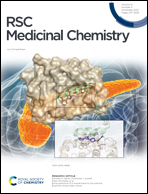Recent progress of small-molecule-based theranostic agents in Alzheimer's disease
Abstract
Alzheimer's disease (AD) is the most common form of neurodegenerative dementia. As a multifactorial disease, AD involves several etiopathogenic mechanisms, in which multiple pathological factors are interconnected with each other. This complicated and unclear pathogenesis makes AD lack effective diagnosis and treatment. Theranostics, exerting the synergistic effect of diagnostic and therapeutic functions, would provide a promising strategy for exploring AD pathogenesis and developing drugs for combating AD. With the efforts in small drug-like molecules for both diagnosis and treatment of AD, small-molecule-based theranostic agents have attracted significant attention owing to their facile synthesis, high biocompatibility and reproducibility, and easy clearance from the body through the excretion systems. In this review, the small-molecule-based theranostic agents reported in the literature for anti-AD are classified into four groups according to their diagnostic modalities. Their design rationales, chemical structures, and working mechanisms for theranostics are summarized. Finally, the opportunities for small-molecule-based theranostic agents in AD are also proposed.

- This article is part of the themed collection: Molecular and Nanotheranostics


 Please wait while we load your content...
Please wait while we load your content...